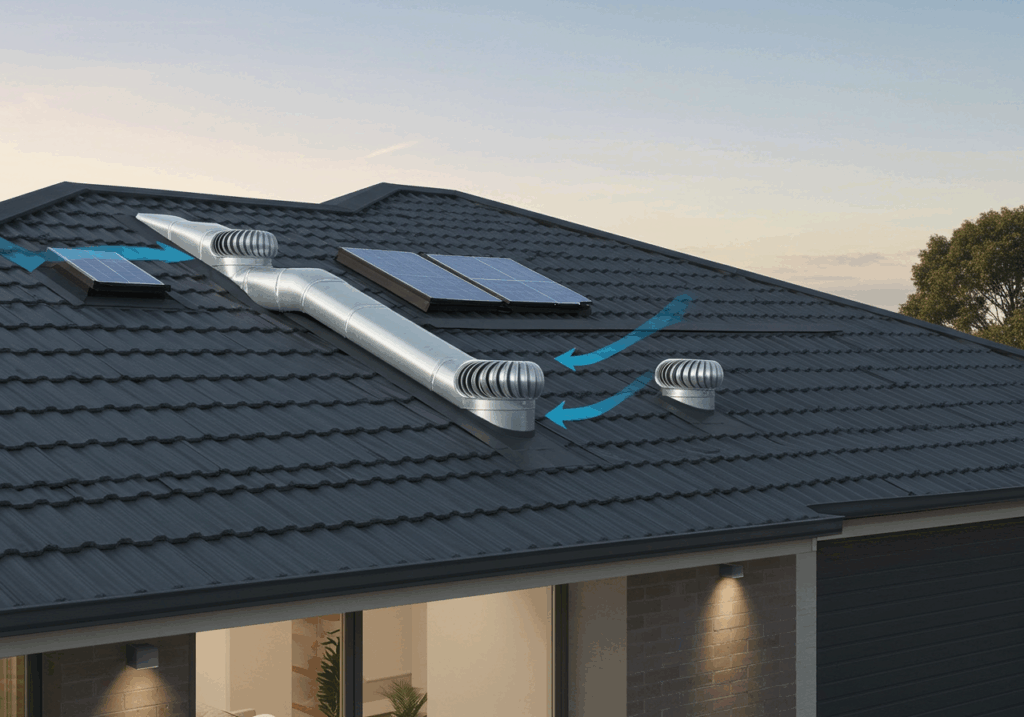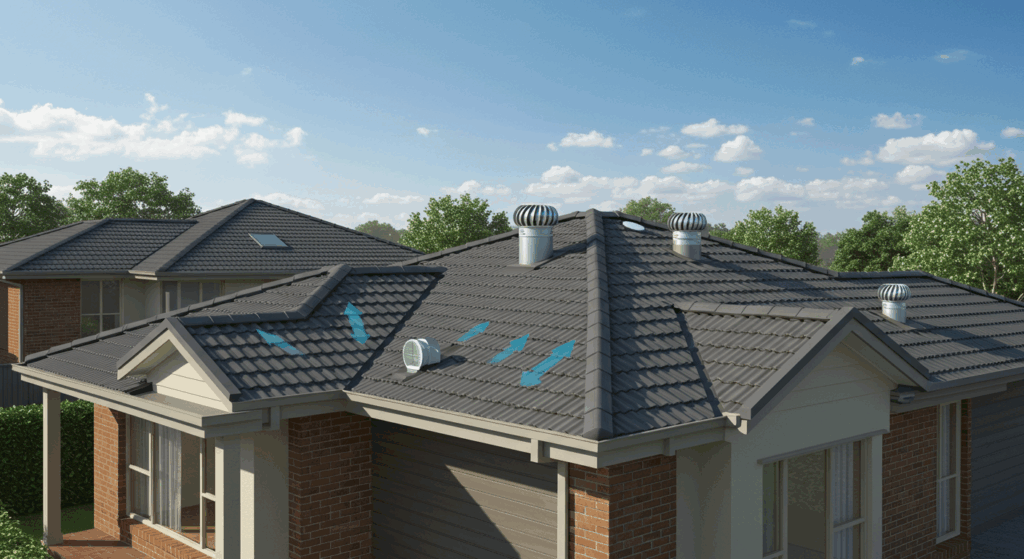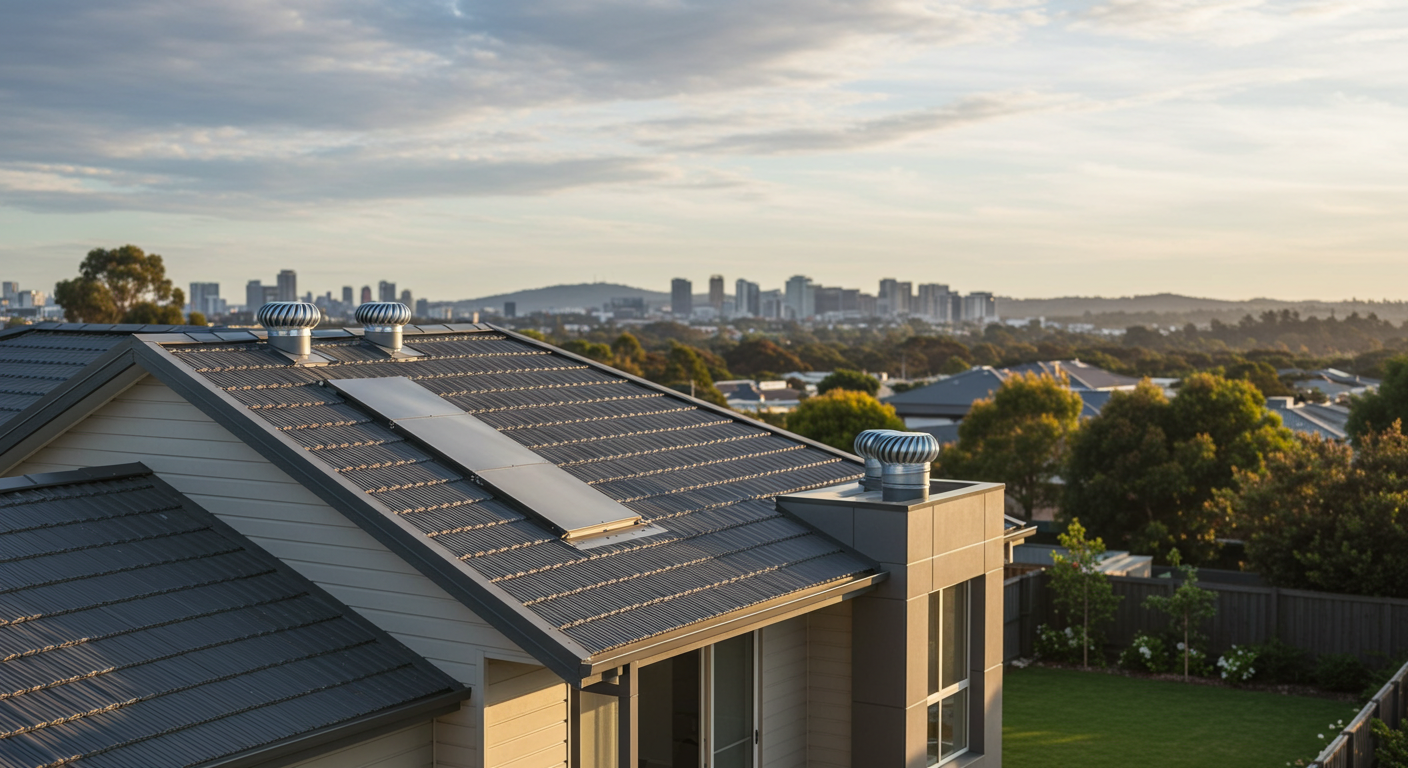If your roof isn’t leaking, you’re in the clear… right?
Not quite.
Most Canberra homes are built with ventilation as an afterthought , or worse, without it altogether. The result? Trapped heat in summer, trapped moisture in winter, and a roof cavity that slowly turns into a silent liability.
Roof ventilation doesn’t get the attention it deserves until mould appears on the ceiling or insulation starts to crumble. But by then, you’re not just dealing with air movement , you’re dealing with damage control.
If you’ve ever walked into your top floor and felt like you’ve entered a sauna, or noticed condensation that never quite dries out, poor roof ventilation is likely the problem.
And yes , the solution might be simpler (and cheaper) than you’d think.
Why Canberra Homes Suffer More Than Most
Canberra’s climate isn’t just “four seasons.” It’s “four seasons in one week.”
That rapid shift , hot to cold, dry to damp , means homes in the region face an unusual mix of roof stresses. But here’s where it gets more nuanced:
Many local homes use tile or metal roofing, which heats up fast and holds that heat longer
Roof pitches tend to be low, leaving minimal airflow space in the cavity
Insulation without proper airflow traps moisture, leading to rot, mould, and degraded ceiling panels
Cold nights followed by warm days create condensation that drips internally
What makes it worse?
Most builders haven’t prioritised ventilation as a standard, especially in homes built before 2000. That means unless you’ve upgraded or retrofitted your roof recently, chances are you’ve got a problem forming up there , even if it hasn’t introduced itself yet.
This isn’t a rare issue. It’s normal. And it’s exactly why roof ventilation in Canberra is critical.
What Roof Ventilation Actually Does (And What It Won’t Do)
Roof ventilation helps your house breathe. It moves trapped air out of the roof cavity and lets fresh air in, keeping temperatures balanced and moisture from building up.
Here’s what proper ventilation does:
- Moves out the hot air that builds up under your roof during the day
- Releases trapped moisture that forms overnight from temperature swings
- Lowers the strain on ceiling insulation and HVAC systems
- Helps stop mould from forming in roof cavities, especially during colder months
It works passively , no electricity required , and when done right, you’ll barely notice it. But you’ll feel it.
Now here’s what ventilation won’t do:
- It won’t fix a damaged roof or make up for missing insulation
- It won’t remove all heat from your home (it regulates the cavity, not your living space)
- It won’t stop leaks, sagging, or structural damage if they’re already happening
Ventilation is a support system, not a magic fix. Think of it like a home’s lungs. If air doesn’t circulate, everything inside gets stale, damp, and stressed.
Whirlybirds: Simple Tech With Real Benefits
Whirlybirds have been around for decades, but not because they’re outdated. They’re still one of the most efficient and low-maintenance ways to ventilate a roof.
How they work:
- They spin using wind power (even low-speed breezes are enough)
- As they spin, they create suction that pulls hot, moist air out of your roof cavity.
- That airflow gets replaced by cooler, drier air from outside
- There are no motors, no power bills, and barely any maintenance involved
Now for the real question , do they work in Canberra?
They do. Canberra’s elevated position and frequent breezes make it an ideal environment for whirlybirds to operate efficiently. Even in calmer conditions, passive airflow through the spinning vents still reduces moisture and heat build-up.
Concerns some homeowners raise:
- Noise? Rare, and usually caused by a faulty installation or debris.
- Appearance? They’re small, low-profile, and can match most roofing colours.
- Wind dependency? Yes, but only mildly , even slight movement improves airflow.
They’re not glamorous. But they’re reliable, tested, and surprisingly effective when installed correctly.

The Real Benefits of Whirlybirds for Canberra Homes
Homeowners in Canberra face a mix of dry summers, frosty winters, and unpredictable shoulder seasons. That’s a unique cocktail of temperature swings and condensation risks , and it’s exactly where whirlybirds shine.
Here’s what a well-installed whirlybird offers in this region:
✓ Reduced Roof Cavity Temperatures
On a hot day, your roof space can exceed 50°C. Whirlybirds help release that trapped heat, lowering the temperature of the ceiling cavity by up to 10°C. That reduces the load on the insulation and cuts down on how hard your air conditioner needs to work.
✓ Less Moisture Build-Up in Winter
During colder months, warm air from the house meets the cold roof surface. That’s how condensation forms , and it slowly eats away at insulation, ceiling plaster, and timber. Whirlybirds allow moisture to escape before it turns into a mould problem.
✓ Healthier Indoor Air Quality
Stale air in the roof space contributes to poor airflow inside. Ventilation reduces the risk of mould spores, allergens, and stuffy air, especially in homes with limited ceiling ventilation.
✓ Extended Lifespan of Roofing Materials
Heat and moisture accelerate the breakdown of tiles, underlay, battens, and insulation. By regulating conditions under the roof, you keep the materials dry and stable for longer, and that translates to fewer repairs down the track.
✓ Passive, Low-Maintenance Operation
There’s no wiring, no switches, no running costs. Just a spinning turbine doing what it was built to do , quietly, consistently, and year-round.

Not Sold on Whirlybirds? Here Are Other Options That Work
If you’re not sure whether whirlybirds suit your roof design or aesthetic, that doesn’t mean you’re out of options. There are several other roof ventilation systems that can work just as well, sometimes better, depending on the build.
✓ Ridge Vents
These run along the peak of your roof and let warm air rise and escape naturally. They’re subtle and effective but require good eave ventilation to function properly.
✓ Gable Vents
Best for homes with gable ends. These allow cross-ventilation when paired with ridge or eave vents , but not every Canberra home has the right structure for them.
✓ Solar-Powered Roof Vents
These use a small solar panel to power a fan that actively draws air out. They’re great for homes with limited wind exposure or where consistent airflow is needed regardless of weather.
✓ Eave Vents (Soffit Vents)
Installed under the eaves to allow cooler air to flow in as warm air is pulled out from above. When combined with a whirlybird or ridge vent, they create balanced, effective airflow.
Which one’s best?
That depends on your roof shape, size, orientation, insulation condition, and existing airflow , which is exactly why a one-size-fits-all answer won’t do anyone any favours.
Why Leaky Roof Recommends Whirlybirds (Only When They Make Sense)
We’ve been on more Canberra roofs than most people have had hot dinners. And after 25+ years of inspecting ceiling cavities, we’ve seen what happens when a home has zero ventilation , and what happens when it’s done right.
Whirlybirds aren’t the answer to every roof problem. But they’re a solid, proven solution when:
- You’ve got a low to moderate pitch roof that traps heat
- There’s no existing airflow through the ridge or eave vents
- You’ve noticed mould, condensation, or high top-floor temperatures
- You want a passive, low-maintenance fix that doesn’t rely on electricity
We don’t recommend them on autopilot.
Our team starts with a proper inspection , not a quick look from the street , and we’ll tell you straight whether ventilation will actually improve your situation. Sometimes it’s not needed. Sometimes another system works better. And sometimes, the real issue is a broken tile or blocked gutter creating the problem.
That’s the difference. We’re not in the business of adding gadgets for the sake of a sale. We’re here to solve real problems, not create new ones.
How to Tell if Your Roof Ventilation Needs Help
You don’t need to climb onto the ceiling with a torch to know if your home is poorly ventilated.
These are the signs we see most often in Canberra homes where the air isn’t moving like it should:
✓ Your roof space feels like a furnace by midday
Even in spring, the cavity becomes an oven, and that heat pushes down into living areas.
✓ There’s a musty smell in your upper rooms
Especially after rain or early in the morning , a clear sign of moisture that’s sitting, not drying.
✓ Mould or discolouration near ceiling corners
A red flag. This means moisture is settling where the air stays still, often caused by condensation, not leaks.
✓ You’ve got uneven room temperatures
Your bedrooms upstairs are boiling, while downstairs feels fine. Poor airflow is usually the culprit.
✓ Peeling paint or swollen cornices
That subtle bulge or bubbling near the ceiling? It’s not just age , it’s trapped moisture, usually inside the cavity.
If any of these feel familiar, it’s worth having the space checked properly. Most ventilation issues go unnoticed for years , until they show up in your paint, plaster, or energy bill.
Think Your Roof Could Use a Breather? Here’s What to Do Next
Roof ventilation isn’t something most homeowners think about , until stale air, rising bills, or signs of mould force the issue. By then, the fix usually costs more than it needed to.
If you’ve noticed any of the signs we covered, or even just have a gut feeling something’s not quite right in the roof cavity, the smartest move is to get it checked.
At Leaky Roof, we offer:
- $99 professional inspections that include detailed reports (not just a guess from the ladder)
- Honest advice on whether ventilation will actually help, or whether the issue lies elsewhere
- Clear, transparent quotes with no sales pressure
- Installation of whirlybirds and alternative ventilation systems tailored to Canberra homes
No jargon. No “limited-time offer” nonsense. Just experienced tradespeople who care about fixing the right thing, not just selling whatever spins.
Book Your Ventilation Inspection Now Or call us directly for advice. If it’s urgent, we’ll prioritise you. If it’s not, we’ll tell you that too.



